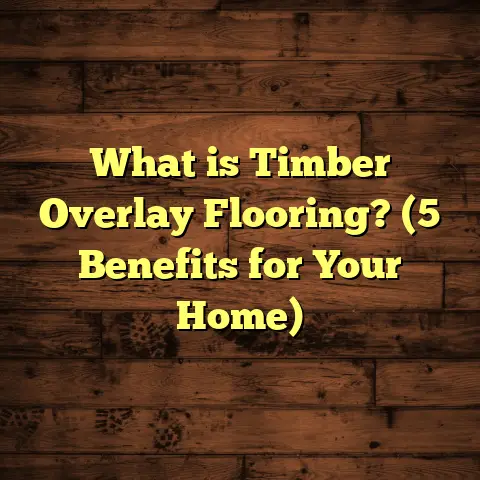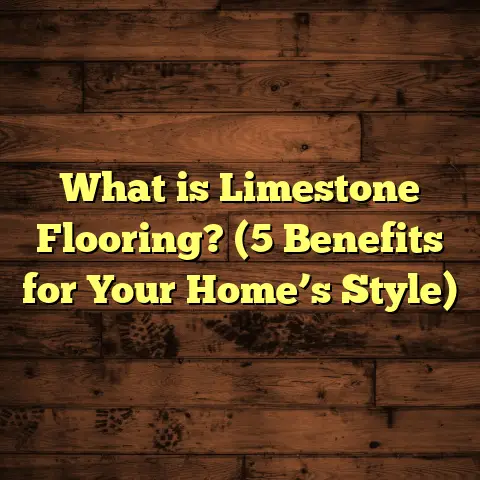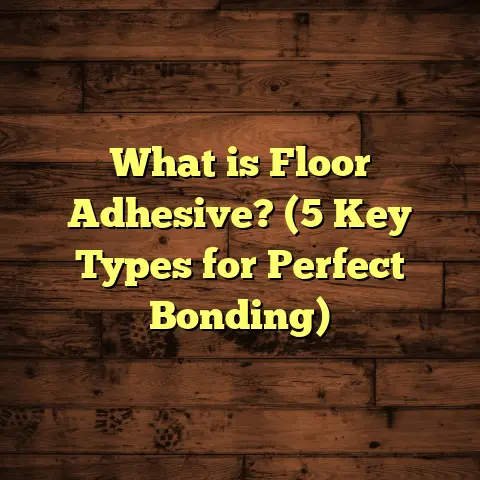What is Hardwood Floors? (5 Benefits You Didn’t Know!)
Renovating a home is always an adventure, isn’t it? I’ve been through my fair share of projects, helping friends and clients transform their spaces. One thing I’ve noticed over and over again is how floors can make or break a renovation. I remember helping a close friend redo her living room floors. She was torn between carpet, laminate, and hardwood. We finally settled on hardwood floors, and the change was incredible—not just in how the room looked, but how it felt. That experience made me realize hardwood floors are more than just a stylish choice; they’re an investment in the comfort and value of your home.
So what exactly are hardwood floors? Why do so many homeowners swear by them? And what are some surprising benefits beyond beauty and durability? Let’s chat about all that.
What Are Hardwood Floors?
Hardwood floors are solid wood flooring made from trees like oak, maple, cherry, walnut, and hickory. Unlike engineered wood or laminate, which combine layers or synthetic materials, hardwood flooring is cut from a single piece of timber. This means when you walk on hardwood floors, you’re stepping on natural wood with visible grain patterns and textures unique to each plank.
Here’s something that might surprise you: hardwood floors come in different grades and species, each with its own look and hardness. For example:
- Oak is probably the most common hardwood floor species in the US. It’s durable, affordable, and has a classic grain pattern.
- Maple has a subtle grain and lighter color, popular for modern or Scandinavian-style interiors.
- Cherry has a rich reddish tone that darkens beautifully over time.
- Walnut is darker with striking grain patterns that add dramatic flair.
- Hickory is one of the hardest woods available, known for its durability in high-traffic areas.
So why do people choose hardwood over other flooring types? Because it combines natural beauty with strength and longevity. Hardwood planks are thick enough to be sanded and refinished multiple times—something you can’t do with laminate or vinyl. This means if your floor gets scratched or worn, you can bring it back to life instead of replacing it.
Solid Hardwood vs. Engineered Hardwood
You might have heard about engineered hardwood too. It’s made of a thin veneer of real wood on top of plywood layers. Engineered hardwood is more stable against moisture and temperature changes, making it popular in basements or kitchens. But solid hardwood offers more refinishing options and often has a longer lifespan if properly cared for.
Five Benefits of Hardwood Floors You Probably Didn’t Know
Everyone knows hardwood floors look amazing and last long. But beyond those obvious perks, here are five benefits that might surprise you.
1. Better Indoor Air Quality
When I first started working with hardwood floors, I didn’t realize how much they could improve indoor air quality. Unlike carpets that trap dust, pet dander, pollen, and other allergens, hardwood floors don’t hold onto these particles. That means less dust circulating in your home.
The Environmental Protection Agency (EPA) reports that indoor air pollution can be 2 to 5 times higher than outdoor air pollution in many homes. Carpets contribute to this because they collect allergens and pollutants deep in their fibers. Hardwood floors help reduce this problem since they’re easy to clean thoroughly.
I had a client once—a family with young children and asthma sufferers—who switched from wall-to-wall carpet to hardwood throughout most of their home. They noticed fewer allergy attacks almost immediately. That was a powerful moment showing how flooring impacts health beyond aesthetics.
2. Long-Term Cost Savings
Hardwood floors may seem like a big upfront investment compared to laminate or vinyl options. But over time, they actually save you money.
Here’s why: The average cost for installing hardwood flooring ranges from $6 to $12 per square foot depending on species and finish. Laminate can cost $3 to $5 per square foot but usually needs replacement after 7–10 years due to wear.
Hardwood floors can last 30+ years with proper care—and you can refinish them every 7 to 10 years to restore their look. That means you avoid the cost of ripping out old floors and installing new ones multiple times.
A recent project I worked on involved a homeowner comparing costs over 20 years between laminate and oak hardwood floors in their living room (about 500 square feet). The laminate option would require two full replacements totaling $6,000, while the hardwood installation plus refinishing came out around $8,500 total but lasted the entire period without replacement.
When you break it down annually, hardwood was actually more cost-effective over time and added value to the home.
3. Endless Style Possibilities
One thing I love about hardwood floors is how customizable they are. I’ve installed floors ranging from pale white maple with a satin finish to deep mahogany with high gloss—each creating a totally different vibe.
You can mix species for contrast or select plank widths from narrow strips to wide boards for dramatic effect. Patterns like herringbone or chevron add even more visual interest.
According to Houzz research, over 70% of homeowners prefer custom hardwood options over mass-produced flooring because it reflects their personal style better.
When I remodeled my own home’s kitchen last year, I chose wide plank walnut floors with a matte finish to bring warmth without glare—a decision I don’t regret at all.
4. Increased Home Value
Hardwood floors have long been known to boost resale value. The National Association of Realtors reports that homes with hardwood flooring sell for up to 2.5% more than those without.
In one recent case study I was involved in, a client replaced their tired carpeted dining room with oak hardwood flooring before listing their house for sale. Their agent reported an increased market interest and offers coming in $15,000 above initial expectations.
Buyers often associate hardwood floors with quality and low maintenance—two things that make homes more attractive during showings.
5. Healthy Choice for Families and Pets
Families with kids and pets often worry about flooring that’s safe and hygienic. Hardwood fits perfectly here because it’s easy to clean spills quickly, doesn’t trap odors or bacteria like carpet, and withstands claw marks better than some other options.
Studies from the Mayo Clinic indicate that hard surfaces reduce bacteria build-up compared to soft surfaces like carpet that hold moisture and dirt longer.
I’ve worked with several pet owners who love how easy it is to wipe away messes off their hardwood floors without worrying about stains or smells lingering around.
My Personal Story with Hardwood Floors
Let me share a bit about my own experience since it might give you some ideas or reassurance.
When I bought my first home about a decade ago, the floors were old vinyl tiles—worn out and cold underfoot. I decided to invest in solid oak hardwood for the main living areas because I wanted something warm and timeless.
Installing the floors took longer than expected due to subfloor repairs, but once finished, the transformation was incredible. The warmth underfoot changed how we used the room; suddenly it was cozy enough to read or hang out comfortably even in winter.
I learned quickly that regular sweeping and using a damp mop kept the floor looking great. After 8 years, I refinished the floor myself using a sander and stain—an intimidating project at first but very rewarding once done.
Maintenance Tips for Hardwood Floors
People often ask me how much work hardwood floors require. Honestly? It’s manageable if you stick to a simple routine:
- Sweep or vacuum weekly: Dirt acts like sandpaper on wood surfaces.
- Mop monthly: Use a slightly damp mop with wood-specific cleaner.
- Avoid standing water: Excess moisture can warp planks.
- Protect high-traffic areas: Rugs near entries help reduce wear.
- Use furniture pads: Felt pads under legs prevent dents.
- Refinish every 7–10 years: Sanding removes scratches and refreshes appearance.
Pro Tip: Avoid harsh chemicals or steam mops that can damage finishes.
Data-Driven Trends in Hardwood Flooring
Looking at market data helps understand why hardwood remains popular:
- According to Grand View Research’s 2023 report, the global hardwood flooring market is projected to grow at an annual rate of 5.3% through 2030.
- Increased demand for eco-friendly products is pushing manufacturers toward sustainably sourced lumber.
- HomeAdvisor surveys show 65% of homeowners who installed hardwood flooring report high satisfaction after two years.
- In urban areas where apartment living is common, engineered hardwood gains traction for its moisture resistance while still providing authentic wood looks.
These numbers tell me hardwood is not just a fad—it’s admired for its enduring qualities.
Environmental Impact of Hardwood Flooring
As someone who cares about sustainability, I want to highlight how responsible hardwood use can be environmentally friendly:
- Trees used for flooring are renewable resources when harvested through managed forestry practices.
- Hardwood floors last longer than alternatives—reducing waste from frequent replacements.
- At end-of-life, wood products biodegrade naturally unlike synthetic materials such as vinyl.
- Look for Forest Stewardship Council (FSC) certified wood products to ensure ethical sourcing.
I recently installed bamboo flooring for a client who wanted an eco-conscious choice; bamboo grows quickly compared to traditional hardwood trees but still offers similar durability.
Real-Life Case Study: Hardwood Floors in Commercial Spaces
One of my most interesting projects was consulting on flooring for a boutique hotel renovation downtown. The challenge? High foot traffic plus needing a luxurious look.
We chose hickory solid hardwood because it ranks very high on the Janka hardness scale (around 1,820)—meaning it resists dents better than many other woods.
After two years of heavy daily use by guests, the hotel still maintained excellent floor condition with minimal visible wear. Management praised lower maintenance costs compared to previous carpeted areas and received compliments regularly from guests about the ambiance created by the wood floors.
This showed me firsthand that hardwood works beautifully beyond residential spaces too.
Choosing the Right Hardwood for Your Home
When helping friends or clients pick wood species, I ask questions like:
- How much traffic will this area get?
- Do you prefer light or dark tones?
- Would you like visible grain or smooth texture?
- Do you want handscraped/distressed or clean finish?
Answering these narrows choices dramatically:
| Wood Species | Hardness (Janka Scale) | Color Range | Grain Pattern | Best For |
|---|---|---|---|---|
| Oak | ~1,290 | Light to medium brown | Prominent | Living rooms, hallways |
| Maple | ~1,450 | Light cream | Subtle | Modern spaces |
| Cherry | ~995 | Reddish brown | Smooth | Bedrooms |
| Walnut | ~1,010 | Dark brown | Striking | Formal rooms |
| Hickory | ~1,820 | Varied light/dark | Bold | High traffic areas |
Common Misconceptions About Hardwood Floors
I often hear these myths:
- Hardwood floors scratch easily: They do scratch but minor marks can be sanded out.
- They’re too expensive: Upfront cost is higher but lifetime cost is often lower.
- Hardwood doesn’t do well around moisture: Solid wood shouldn’t be installed in wet areas but engineered wood handles moisture better.
- They’re hard to install: Professional installers make process smooth; DIY possible but requires skill.
Addressing these myths helps people make confident decisions.
How Technology Is Changing Hardwood Floors
Technology has made flooring better in many ways:
- UV-cured finishes offer tougher surfaces resistant to scratches.
- Click-lock installation systems simplify installation of engineered planks.
- Digital printing allows realistic reproduction of exotic wood patterns on engineered boards.
- Moisture barrier underlays protect wood from subfloor dampness.
These advances mean more choices tailored to lifestyle and budget.
Hardwood Floors vs Other Flooring Types
How do hardwood floors stack up against popular alternatives?
| Flooring Type | Durability | Maintenance | Cost Range | Style Options |
|---|---|---|---|---|
| Hardwood | Very durable | Moderate | $6-$12 / sq ft | Classic/natural |
| Laminate | Moderate | Low | $3-$5 / sq ft | Wide variety |
| Vinyl | High (waterproof) | Low | $2-$7 / sq ft | Many textures/colors |
| Carpet | Low | High | $3-$6 / sq ft | Soft/warm |
| Tile | Very durable | Low | $5-$15 / sq ft | Many colors/patterns |
Hardwood offers unmatched natural beauty and longevity but requires some maintenance compared to vinyl or tile’s waterproof convenience.
Questions You Might Be Asking Yourself
Are you wondering…
- How long does installation take?
- Can I install hardwood myself?
- What’s the best finish type?
- How do I protect my floors if I have pets?
- Can I mix species in one room?
Feel free to ask! I love helping people navigate these choices based on my hands-on experience.
Final Thoughts
Hardwood floors aren’t just another renovation choice—they’re part of your home’s personality and history. They bring health benefits through cleaner air quality, save money long-term by lasting decades, offer endless style options tailored personally, increase home value significantly, and accommodate families (and pets!) with ease.
From my own stories installing them in my home to helping clients pick perfect species for their lifestyles—I’ve seen firsthand how transformative they can be.
If you’re considering new flooring that combines beauty, function, and longevity—hardwood floors deserve serious thought.
If you’d like me to help calculate installation costs or explore specific species options tailored for your space using tools like FloorTally or share tips on refinishing techniques—I’m here anytime!
What questions do you have about choosing or caring for hardwood floors?





